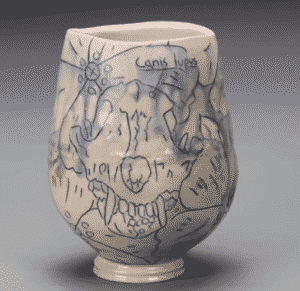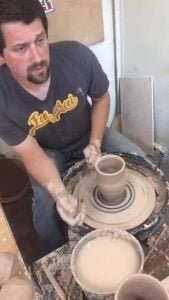So, you’re just starting out on your ceramic journey and everything’s exciting, right? All those shiny ribs, ribbon tools, and mark makers at your neighborhood pottery store are downright irresistible! But then, the cashier rings up your haul and… Yikes!
Now, we’re not saying these tools aren’t incredibly useful or well-crafted — they absolutely are. But if you’re on a mission to save some money, or if you enjoy the creative process of repurposing (or recycling) objects, we have a treat for you! Join us as we go on a thrifty adventure to find 8 everyday household items that can transform your pottery toolbox.

1. Wooden Spoons and Spatulas
These are fantastic additions for the ceramicist tool kit, particularly if you are a hand builder. They can replace the wooden paddles you find at the pottery store, and often work better than the cheaper particle board models you may come across. Their edges are nicely rounded, which prevents dents and marks from occurring as you paddle your form into shape. And best of all, they come in a variety of sizes and shapes, allowing you greater flexibility when working on more complex shapes.
Spoons and spatulas are also indispensable for mixing, whether it be slips, underglazes, or glazes. The back end of the handles also work great as stir sticks for smaller containers.

2. Rolling Pin
If you are a slab builder, this will become your favorite tool, especially if you don’t have the space or money for that shiny new slab roller. Wood is best because its porous nature prevents clay from sticking, and you will find that rollers with fixed handles offer the greatest stability and strength.
If you are up for a creative challenge, try carving into your rolling pin with wood carving tools to create a custom roller stamp!

3. Old Credit Cards and Membership Cards
Before you toss that expired plastic card into the trash, consider repurposing it as a custom rib! By cutting simple curves and grooves into the sides of the card, you’ll create unique ribs for use on the wheel to enhance the design of your foot, walls, and rims. Best of all, you can use all sides of the card for a 4-in-1 tool.
For an excellent tutorial, we recommend this article by Garrity Tools: https://www.garritytools.com/clayclub/2021/04/make-your-own-rib

Example Dough scraper available on Ebay. Click here for more
4. Dough Scraper
Dough scrapers offer many benefits to the artist’s studio. For all types of makers, they are excellent for removing moist or dry clay build-up from your work surface. Use just as you would if baking, but remember to wear a respirator if clearing away dry clay.
Scrapers also make fantastic cutting tools for slab-builders. They are sturdily built so will not bend as you press, and less cumbersome than a knife and ruler when measuring is not required. If desired, you can etch in ruler marks to make it more versatile.

Example Lazy Susan, available here on Amazon
5. Lazy Susan
While they can’t completely replace a good metal banding wheel, Lazy Susans offer an affordable substitute. Any material is fine, with wood offering great absorbency. They work great for any process requiring manual rotating, whether that be fluting a mug or carving a sculpture. There are a variety of diameters available, with heavier models providing the greatest stability.
Already have a metal banding wheel? Lazy Susans are a light-weight alternative to bring if you are traveling to residencies or workshops that don’t provide all the necessary tools.
If desired, you can even customize your Lazy Susan by drawing or carving in guidelines and measurements!

6. Cookie Cutters
Cookie cutters are excellent tools to add to your kit, particularly if you are a slab-builder. A set of circular or square cutters can be a huge time saver when making mug bases or small dishes. They also work great for making small tiles, ornaments, and simple sprigs. Cookie cutters are available in an endless variety of shapes, and you can customize your form once it has been cut by shaping, layering, and carving.

7. Metal Spoons
If you’ve come across pots with a rich, satin-smooth unglazed surface, you are likely familiar with the technique of burnishing. Burnishing compresses the clay’s surface to make it smooth and more water resistant, and is achieved by rubbing the surface with a hard object and light moisture.
Metal spoons are fantastic tools for achieving this beautiful effect. The cup of the spoon provides a rounded surface that will compress the clay without scoring it, and the handle makes the process more comfortable. Having a teaspoon and a tablespoon in your studio is a great way to explore this lovely technique!

8. Nylons
Sometimes you find an item that would work great as a mold, only to discover that your clay sticks to it. Nylons offer a great solution for this. Simply cut a length of the leg, keeping the toe intact, stretch it over your form, and tie off. Tie the knot as close to the form as you can for a tight fit, and cut off any excess material. If your form is small, you can add an extra layer by tightly twisting on one end and pulling back over the first layer before tying off. You now have a porous layer on your mold that will greatly reduce sticking! As an added measure, you can rub a small amount of corn starch over the nylon for a truly non-stick surface.
Nylons only work on small to medium-sized forms, but they are an affordable way to make everyday items into molds for hand building. While they do need to be replaced with use, you can often get 2-4 coverings out of one pair!
This list is just a small example of items that you can bring from your home into the studio. Once you start the process, you will begin to see everything as a potential tool! And, if you would really like to try out the items on this list but don’t have them on hand, why not head to your local thrift or charity shop, where you can save money while also reducing waste.
Already have some ideas for household items-turned-pottery tools of your own? Head on over to our community forum to share your own MacGyver-inspired creativity!






Responses